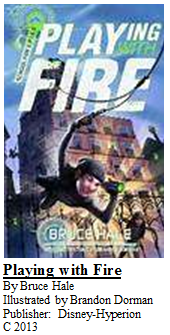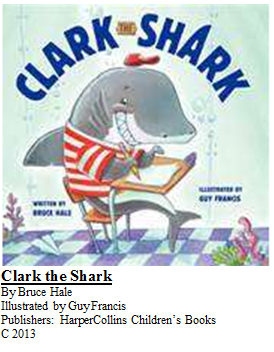Who would ever imagine that a Read Aloud during the last day of the school year could excite kids about summer reading? Our school year ended mid-July. My 4th grade students were thinking of signing autograph books, having the class party, and watching a DVD of “Despicable Me.” To top it off, it was a minimum day! A chemistry of chaos was brewing in my classroom.

 Children’s Book Author Bruce Hale has come out with two new books: Playing with Fire (School for S.P.I.E.S. Book 1), a middle grade novel, and Clark the Shark, a picture book. I decided to read the books after our morning “mini break” walk/jog around the basketball courts. After our break, the kids were ready to sit through the Read Aloud.
Children’s Book Author Bruce Hale has come out with two new books: Playing with Fire (School for S.P.I.E.S. Book 1), a middle grade novel, and Clark the Shark, a picture book. I decided to read the books after our morning “mini break” walk/jog around the basketball courts. After our break, the kids were ready to sit through the Read Aloud.
Clark the Shark was an enjoyable read and had the kids laughing up a storm. We did a mini stretch and I proceeded to read Chapter One of Playing with Fire. Since my students were familiar with Hale’s Chet Gecko mystery series and Snoring Beauty, they were excited to hear about his new books. They noticed the amped vocabulary in a middle grade novel. Also, they loved the book’s main character, a foster “kid” named Max. Nothing seemed to go right for Max as he was sent from one foster home to another. His new start at Merry Sunshine Orphanage brought a cloud of doubt over his character. Max was on a mission to prove his innocence and clear himself of the string of wrongdoings.
Teaching moments can come in small increments and I found this to be true. All throughout the school year, I taught mini lessons on author’s craft for both fiction and nonfiction. So, as I read Chapter One of Playing with Fire, I stopped at the last page. From my “teacher’s tool bag,” I asked the students a question. Here’s the brief version of what happened:
Teacher: “So how old do you think Max is?”
The students made an educated guess. One of my English Language Learners raised his hand and guessed Max’s age as 13 years old. Other students chimed in. With the Common Core Standards in mind, I asked him what was the evidence from the story to help him figure out Max’s age.”
He responded, “Max talked like a 13 year old.”
We continued to look at the dialogue and other examples in Chapter One.
Most books have the main character’s age at the beginning of a story, but having it at the end of the chapter provided a fun opportunity for students to guess at Max’s age. An author’s craft in writing “age-appropriate dialogue” clearly stood out in Playing with Fire. My students range from ELL (English Language Learners) and GATE (Gifted and Talented Education) and though they are now incoming 5th graders, the middle grade novel Playing with Fire became a popular vote to add on to our Summer Reading List.
For more information:
Children’s Book Author Bruce Hale, visit http://brucehale.com/
Shark the Clark: http://www.harpercollinschildrens.com/books/Clark-Shark/
Shark the Clark Book Trailer: http://www.youtube.com/watch?v=hJVgQFW3Be8&feature=youtu.be
Shark the Clark, Book Illustrator Guy Francis (http://www.guyfrancis.com/Kactiguy/Home.html)
School for S.P.I.E.S. website: http://school4spies.com/
Schools for S.P.I.E.S. video: http://school4spies.com/video/
Playing with Fire, Book Illustrator Brandon Dorman (http://brandondorman.com/)
Playing with Fire
(Possible Common Core Standards Connections in READING LITERATURE):
Grade 6: Key Ideas and Details (http://www.corestandards.org/ELA-Literacy/RL/6)
* CCSS.ELA-Literacy.RL.6.3. Describe how a particular story’s or drama’s plot unfolds in a series of episodes as well as how the characters respond or change as the plot moves towards a resolution.
Grade 7: Craft and Structure (http://www.corestandards.org/ELA-Literacy/RL/7)
* CCSS.ELA-Literacy.RL.7.4. Determine the meaning of words and phrases as they are used in a text, including figurative and connotative meanings; analyze the impact of rhymes and other repetitions of sounds (e.g., alliteration) on a specific verse or stanza of a poem or section of a story or drama.
Grade 8: Key Ideas and Details (http://www.corestandards.org/ELA-Literacy/RL/8)
**CCSS.ELA-Literacy.RL.8.3. Analyze how particular lines of dialogue or incidents in a story or drama propel the action, reveal aspects of a character, or provoke a decision.


